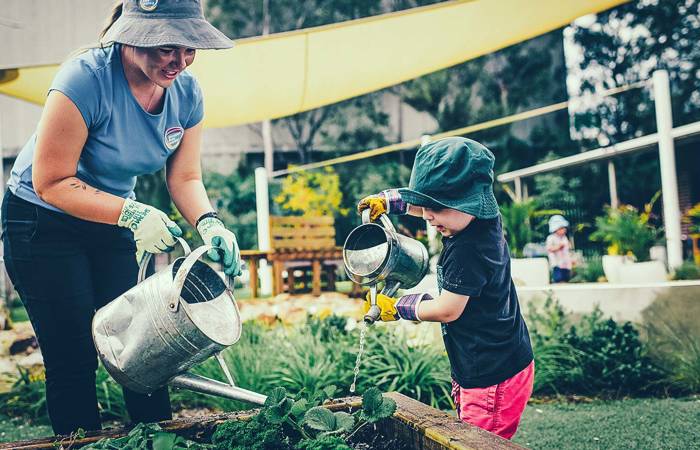Like what you see?
Sign up to receive more free parenting advice.
Thank you for subscribing to our newsletter!
Early Learning

Credit: iStock.com/Rawpixel
Many parents are anxious about sending very young children to a long-day-care centre. Professor of Early Childhood Sheila Degotardi answers the questions: Should parents be worried? What does research tell us about the impact on very young children?
The benefit of preschool for children over the age of three is now well accepted. Many studies have shown that when children attend high quality preschool programs, they are better prepared for school and demonstrate gains in academic and social skills that last into their primary school years and beyond.
However, there is less recognition of the benefits of infant and toddler early childhood programs. Many parents are anxious about sending their very young children to a long-day-care centre, with messages like “Childcare is bad for babies” or “They’re too young” resonating in their minds.
Should parents be worried? What does research tell us about infant and toddler early childhood programs and their impact on very young children and their families?
Researchers have been seeking an answer this question for some decades, with a first wave of studies in the 1980s trying to determine whether childcare really was “bad for babies”.
In one influential US study1, the focus was on the importance of the parent-infant relationship and whether childcare attendance would damage that relationship and therefore harm the child.
The findings caused serious consternation – infants who were cared for by someone other than their parent for more than 20 hours per week were more likely to have an insecure attachment relationship with their parents than those who did not attend out-of-home care. The researchers concluded that childcare attendance in infancy posed serious risks to children’s social-emotional development. However, a recent study of over 75,000 children in Norway2 found no evidence of ill effects related to childcare. Young children who attended early childhood programs during infancy showed no increased evidence of social or emotional difficulties. Other more recent studies in the US have also found positive effects related to attendance in infant-toddler childcare[e.g., 3, 4].
So what is the reason for these different reseach findings?
The simple answer is quality!
Early studies did not take the quality of the infant-toddler program into account. Both in Australia and abroad, infant-toddler programs differ in the quality of the experience that they provide. Once researchers started to look at the quality of these experiences, they quickly established that infant-toddler early childhood programs did not harm young children.
In fact, they found quite the opposite. High quality infant-toddler programs supported early development and learning. Benefits of high quality centres extended beyond supporting the development of close relationships with parents and educators, to include social skills, early language development and early academic skills.
So, the evidence is now clear – infant-toddler early childhood programs are not “bad for children”! On the contrary, when the quality is high, infant-toddler programs can enrich the lives and learning of our youngest children.Professor Sheila Degotardi
Stay up to date with the latest news and articles from First Five Years
Thank you for subscribing to our newsletter!
What constitutes ‘quality’?
The cornerstone of quality for infants and toddlers is the nature of their interactions with educators. High quality interactions are characterised by:
- warm, emotionally supportive interactions with available and responsive educators;
- lots of talk about what the young child and others are doing and experiencing;
- to-and-fro exchanges where feelings, interests and ideas are shared and responded to; and
- educator attentiveness to, and support of early learning, including the encouragement of sensory and exploratory play, problem-solving and creative expression.
Quality also involves the provision of interesting and varied learning experiences. Infants and toddlers need materials to explore and play with in ways that meets their current learning abilities and sparks their curious minds.
They need opportunities to move and use their bodies as they become more mobile and coordinated. They need experience with language and self-expression through story-reading, singing, art and sensory play. And they need predictable routines and warm, unhurried caregiving experiences.
When these ingredients come together, the program quality is high and infants and toddlers are content, relaxed and busy learners! The early childhood centre offers an extension to the experiences that they have at home with their family – a fun and stimulating place where they form close relationships with educators and peers, and where they can play and learn in a supportive environment.
How is high quality assured in Australian early childhood infant-toddler programs?
Importantly, research has shown that early childhood employers can put in place provisions to increase the quality of infant-toddler programs.
Three features – educator qualifications and opportunities for professional growth, group size, and child/educator ratios – have been identified as central supports for high quality infant and toddler programs 5. No single feature predicts the quality of any infant-toddler program. Instead, these three elements work together to enable educators to engage in high quality interactions with very young children.
Qualified educators have the professional knowledge to know what constitutes high quality interactions and how to set up an environment that meets the varied learning capabilities of all of children in the group. Small group sizes and low child/educator ratios allow educators to be attentive, responsive and relaxed, increasing their ability to provide emotionally warm and positive interactions.
Fortunately, Australia has Education and Care Services National Regulations which stipulate the qualification levels and child/educator ratios that are required in infant-toddler rooms. A set of National Quality Standards require the centres meet a minimum standards in relation to educator-child interactions and the educational program.
While these provisions alone cannot ensure that an infant-toddler program will be of high quality, the National Quality Framework does give parents reassurance that the importance of quality is recognised and taken seriously.
So, the evidence is now clear – infant-toddler early childhood programs are not “bad for children”! On the contrary, when the quality is high, infant-toddler programs can enrich the lives and learning of our youngest children.
1. Belsky, J. and M.J. Rovine, Nonmaternal care in the first year of life and the security of infant-parent attachment. Child Development, 1988. 59(1): p. 157-167.
2. Zachrisson, H.D., et al., Little evidence that time in child care causes externalizing problems during early childhood in Norway. Child Development, 2013. 84(4): p. 1152-70.
3. National Institute of Child Health and Human Development Early Child Care Research Network, Early child care and children's development prior to school entry: Results from the NICHD study of early child care. American Educational Research Journal, 2002. 39(1): p. 133-164.
4. Yazejian, N., et al., Child and parenting outcomes after 1 year of Educare. Child Development, 2017.
5. Dalli, C., et al., Quality early childhood education for under-two-year-olds: What should it look like? A literature review. 2011, Ministry of Education: Wellington, NZ.








